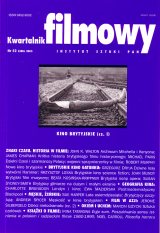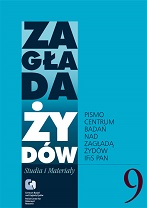We kindly inform you that, as long as the subject affiliation of our 300.000+ articles is in progress, you might get unsufficient or no results on your third level or second level search. In this case, please broaden your search criteria.

Film directors and producers basically regard the credits and other titles as necessary evil, not paying much attention to their design, fonts, dynamics and the possibility of setting the mood for the film story that follows. Giżycki concentrates on a few examples offering a creative approach to the style and design of film’s opening sequences, usually created to present the title and names of the major artists involved in the creation of a film. To make his point, Giżycki examines the work of Saul Bass (the author of title sequence for Arthur Hitchcock’s "Vertigo"), Pablo Ferro ("Dr. Strangelove", "Bullitt", "Midnight Cowboy"), Stephen Frankfurt ("To Kill a Mockingbird"), Maurice Binder ("Barbarella", "The Private Life of Sherlock Holmes") and Kyle Cooper who designed the famous opening sequence of David Fincher’s "Seven".
More...
In her essay on the history of British soaps, Kosińska-Krippner examines five most significant British soap opera serials "Coronation Street", "EastEnders", "Crossroads", "Emmerdale" and "Brookside". She compares the typical features of British soaps with their U.S. and Australian counterparts and shows some aspects of the reception of soap operas on British soil. The essay discusses the state of British research on soap operas, especially the latest findings of Dorothy Hobson, one of Britain’s leading soap opera commentators, who has traced the development of the genre in Great Britian for over 20 years.
More...
Dryja discusses ups and downs of the almost fifty year-long history of Britain’s Hammer Film Productions whose films played a significant role in the development of entertainment cinema. Dryja argues that the films were made according to the so-called “Hammer formula”, which allowed them to develop own aesthetics. Their characteristic features and style were responsible for shaping pop culture in a special way and inspired known directors (Francis Ford Coppola – "Dracula" or Kenneth Branagh - "Frankenstein"). Dryja reviews successive films (starting from Hammer’s first movies in the 1930s through its heyday in the 1950s and 1960s until its decline), making a parallel analysis of their themes, style, genre, the way they corresponded with Hollywood-made counterparts, and issues connected with the Hammer policy and economic aspects of its operations.
More...
Some critics say that the development of the British science fiction cinema of 1929-1966 was overshadowed by American sci-fi film productions, which was reflected both by thematic similarities (the threat of nuclear war, the fear of alien invasions or of effects of radioactive radiation), and the attitude towards science or technology, related with the pessimistic assessment of civilisational development, and threats caused by the application of new technologies. Over the years the rationalist paradigm of science fiction gave way to “catastrophic imagination”. Scientists were replaced by monsters, and the utopian restructuring of society turned into visions of global destruction. However, British sci-fi films differ from their American counterparts, the difference being the result of the vitality of the Gothic tradition in Britain and popularity of television serials successfully adapted for the silver screen. You can see no impact of cartoons with stories of supermen fighting evil, which were so important in the American cinema of the interwar period, on British cinema.
More...
This essay discusses representation of Blackpool in film as a special case amongst British postmodern cinematic cities. Its postmodernism not only follows the changes which affected the ‘real’ city in the last decades and the postmodern style of the 1980s and 1990s cinema, but to a large extent results from the fact that it was always, in a sense, postmodern. Many of the features associated with postmodernism existed in the city, and were identified by historians before the term ‘postmodernism’ started to be widely used. After presenting a brief history of Blackpool as the most cosmopolitan British holiday resort, patronised mostly by the working classes, the essay explores the shifts in portrayal of Blackpool that took place between 1927 the premiere of a silent box-office hit "Hindle Wakes", directed by Maurice Elvey to "Bhaji on the Beach" (1993), directed by Gurinder Chadha and "Funny Bones" (1994) by Peter Chelsom, through "Sing As We Go" (1934), directed by Basil Dean and "Taste of Honey" (1961) by Tony Richardson, using as the main methodological perspective Jonathan Raban’s concept of a ‘soft city’.
More...
Abstract. Romania has experienced significant migration since 1990, and this migration has had diversified effects on Romanian society. This article analyzes Romanian migration in the period after 1990, highlighting some of the most noticeable effects produced by international migration during this time. Romanian migration is characterized by a high degree of selforganization. It has had changing causes and patterns of organization in each of the distinct periods after 1990. The first period, from 1990 to 1993, was characterized by migration to Germany with additional migration of Romanians to a host of other European countries. This first period was followed by a relatively stable period. After 1997, however, we argue that massive restructuring of the Romanian economy forced unemployed Romanians to migrate irregularly. After 2002, the pattern of Romanian migration altered yet again, because citizens of Romania were allowed to travel to EU countries without restrictions. Consequently, migration levels increased massively. After 2007, Romanians benefited from EU accession. There were diverse consequences of this movement of migrants. These included a significant in-flow of remittances and measurable effects on the labor market that caused the reorganization of households and gender relations.
More...
Abstract. This paper deals with global tendencies of migration. It points out that, for several reasons, in comparison with commodities, services, technology, not to mention capital, labour is still the least liberalized production factor. Nevertheless, migration pressure, international competition and the strategies of many countries and companies presage a rapidly growing share of non-native workers in the total labour force. In contrast to classical migration research that focused on the impact of migration on host/target countries, the author deals with the equally significant impacts on sending/emigration countries. First, ambiguous consequences for these countries’ labour markets are analyzed, including regional and social implications. Second, the well-known and often disputed “brain drain – brain gain – brain waste” issue is addressed. A special section deals with the – again ambiguous – impact of financial transfers from workers employed abroad to their relatives at home. Finally, potential policy responses that would allow sending countries to minimize the losses and maximize the benefits derived from various forms of migration are presented.
More...
Abstract. The combination of emigration and internal migration from peripheral areas to larger cities has crucially changed and shaped societal and spatial structures in Albania during the post-communist era. Some peripheral regions within the country itself suffer from extreme depopulation, resulting in partial abandonment of settlements. At the same time, the country’s central region experiences an unregulated, hardly controllable influx of migrants, who frequently foster close connections with their regions of origin. Even in the case of emigration, connections and relations with one’s home country are rarely completely cut off. Manifold backlashes of migration on regional and local development can thus be observed in Albania itself. This includes, for example, remittances of respectable amounts, which help families to secure their livelihood and often serve as seed capital for entrepreneurial independence as returnee’s business. There is even evidence of effects on the country’s cultural landscape through a kind of rent seeking mentality; for in those regions where the amount of private remittances from abroad received by households is high, the areas of fallow agricultural land are particularly large.
More...
War crimes trials roused considerable resistance in Germany. Here the author analyzes opposition to the Malmédy Trial, conducted at Dachau in 1946, citing documents made available under the 1998 Nazi War Crimes Disclosure Act – in particular those of Roman Catholic auxiliary bishop of Munich Johannes Neuhäusler and regional Protestant bishop Theophil Wurm of Württemberg. These clergymen helped reduce sentences and obtain clemency for perpetrators. Munich lawyer and activist Rudolf Aschenauer, a close associate of Neuhäusler, coordinated a large network devoted to thwarting the convictions of the former Waffen-SS men. The author traces U.S. Army Counterintelligence Corps (CIC) monitoring of both Aschenauer and the bishops.
More...
Wokół książki Moniki Polit “My Jewish Soul Fears Not Judgment Day”. Mordechaj Chaim Rumkowski. Truth and Fiction [Michał Głowiński, Andrea Löw, Agnieszka Żółkiewska] Monika Polit - A Reply to Reviewers Adam Puławski - Remarks and Reflections on the Educational Publication Zrozumieć Holokaust [To Understand the Holocaust] Robert Szuchta, Piotr Trojański - How to Wrote Textbooks on the Holocaust? Notes on the Review of Zrozumieć Holokaust
More...
The Mersik–Tenenbaum archive is a collection of documents assembled in the Bialystok ghetto in the years 1942-1943 by Dror He-Chaluc activists: Mordechaj Tenenbaum-Tamarof, Cwi Mersik and Gedalia Petluk, consisting of accounts, diaries, records of the Jewish Council, leaflets, letters, and personal documents. These materials were hidden outside the ghetto in a house of a Pole, Dr. Bolesław Filipowski, in 1943 and found in 1944 or 1945 by Lejb Blumental, brother of the late Izrael Blumental, who was involved in hiding the documents. Some of the surviving material was sold to the Central Jewish Historical Commission and to this day remains in the archives of the Jewish Historical Institute in Warsaw, while others came to the Commission in duplicates, and some originals are in Israel, where they are scattered in the different centers. Most likely some part of the Underground Archive has not been found until today.
More...
Dreams, typically used as material for psychotherapy, may also be a historical source, testifying to the experiences of specific people in a certain cultural context and at a particular historical moment. Dreams dreamed during the Holocaust illustrate the wealth of emotions of the victims, their unspeakable experiences, as well as their longing for their loved ones.
More...